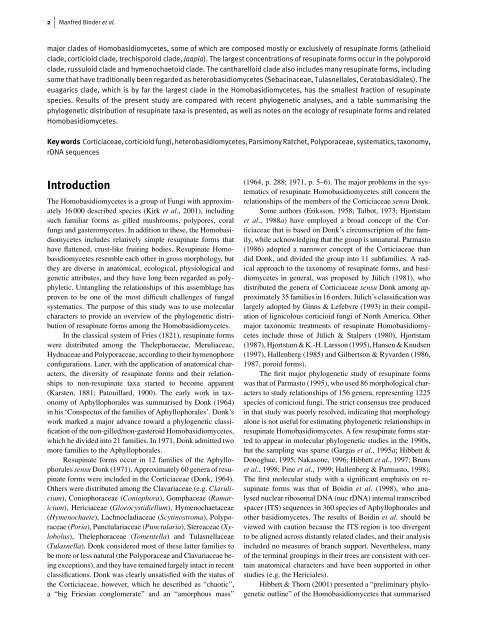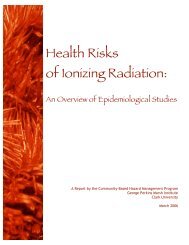The phylogenetic distribution of resupinate forms ... - Clark University
The phylogenetic distribution of resupinate forms ... - Clark University
The phylogenetic distribution of resupinate forms ... - Clark University
Create successful ePaper yourself
Turn your PDF publications into a flip-book with our unique Google optimized e-Paper software.
2 Manfred Binder et al.<br />
major clades <strong>of</strong> Homobasidiomycetes, some <strong>of</strong> which are composed mostly or exclusively <strong>of</strong> <strong>resupinate</strong> <strong>forms</strong> (athelioid<br />
clade, corticioid clade, trechisporoid clade, Jaapia). <strong>The</strong> largest concentrations <strong>of</strong> <strong>resupinate</strong> <strong>forms</strong> occur in the polyporoid<br />
clade, russuloid clade and hymenochaetoid clade. <strong>The</strong> cantharelloid clade also includes many <strong>resupinate</strong> <strong>forms</strong>, including<br />
some that have traditionally been regarded as heterobasidiomycetes (Sebacinaceae, Tulasnellales, Ceratobasidiales). <strong>The</strong><br />
euagarics clade, which is by far the largest clade in the Homobasidiomycetes, has the smallest fraction <strong>of</strong> <strong>resupinate</strong><br />
species. Results <strong>of</strong> the present study are compared with recent <strong>phylogenetic</strong> analyses, and a table summarising the<br />
<strong>phylogenetic</strong> <strong>distribution</strong> <strong>of</strong> <strong>resupinate</strong> taxa is presented, as well as notes on the ecology <strong>of</strong> <strong>resupinate</strong> <strong>forms</strong> and related<br />
Homobasidiomycetes.<br />
Key words Corticiaceae, corticioid fungi, heterobasidiomycetes, Parsimony Ratchet, Polyporaceae, systematics, taxonomy,<br />
rDNA sequences<br />
Introduction<br />
<strong>The</strong> Homobasidiomycetes is a group <strong>of</strong> Fungi with approximately<br />
16 000 described species (Kirk et al., 2001), including<br />
such familiar <strong>forms</strong> as gilled mushrooms, polypores, coral<br />
fungi and gasteromycetes. In addition to these, the Homobasidiomycetes<br />
includes relatively simple <strong>resupinate</strong> <strong>forms</strong> that<br />
have flattened, crust-like fruiting bodies. Resupinate Homobasidiomycetes<br />
resemble each other in gross morphology, but<br />
they are diverse in anatomical, ecological, physiological and<br />
genetic attributes, and they have long been regarded as polyphyletic.<br />
Untangling the relationships <strong>of</strong> this assemblage has<br />
proven to be one <strong>of</strong> the most difficult challenges <strong>of</strong> fungal<br />
systematics. <strong>The</strong> purpose <strong>of</strong> this study was to use molecular<br />
characters to provide an overview <strong>of</strong> the <strong>phylogenetic</strong> <strong>distribution</strong><br />
<strong>of</strong> <strong>resupinate</strong> <strong>forms</strong> among the Homobasidiomycetes.<br />
In the classical system <strong>of</strong> Fries (1821), <strong>resupinate</strong> <strong>forms</strong><br />
were distributed among the <strong>The</strong>lephoraceae, Meruliaceae,<br />
Hydnaceae and Polyporaceae, according to their hymenophore<br />
configurations. Later, with the application <strong>of</strong> anatomical characters,<br />
the diversity <strong>of</strong> <strong>resupinate</strong> <strong>forms</strong> and their relationships<br />
to non-<strong>resupinate</strong> taxa started to become apparent<br />
(Karsten, 1881; Patouillard, 1900). <strong>The</strong> early work in taxonomy<br />
<strong>of</strong> Aphyllophorales was summarised by Donk (1964)<br />
in his ‘Conspectus <strong>of</strong> the families <strong>of</strong> Aphyllophorales’. Donk’s<br />
work marked a major advance toward a <strong>phylogenetic</strong> classification<br />
<strong>of</strong> the non-gilled/non-gasteroid Homobasidiomycetes,<br />
which he divided into 21 families. In 1971, Donk admitted two<br />
more families to the Aphyllophorales.<br />
Resupinate <strong>forms</strong> occur in 12 families <strong>of</strong> the Aphyllophorales<br />
sensu Donk (1971). Approximately 60 genera <strong>of</strong> <strong>resupinate</strong><br />
<strong>forms</strong> were included in the Corticiaceae (Donk, 1964).<br />
Others were distributed among the Clavariaceae (e.g. Clavulicium),<br />
Coniophoraceae (Coniophora), Gomphaceae (Ramaricium),<br />
Hericiaceae (Gloeocystidiellum), Hymenochaetaceae<br />
(Hymenochaete), Lachnocladiaceae (Scytinostroma), Polyporaceae<br />
(Poria), Punctulariaceae (Punctularia), Stereaceae (Xylobolus),<br />
<strong>The</strong>lephoraceae (Tomentella) and Tulasnellaceae<br />
(Tulasnella). Donk considered most <strong>of</strong> these latter families to<br />
be more or less natural (the Polyporaceae and Clavariaceae being<br />
exceptions), and they have remained largely intact in recent<br />
classifications. Donk was clearly unsatisfied with the status <strong>of</strong><br />
the Corticiaceae, however, which he described as “chaotic”,<br />
a “big Friesian conglomerate” and an “amorphous mass”<br />
(1964, p. 288; 1971, p. 5–6). <strong>The</strong> major problems in the systematics<br />
<strong>of</strong> <strong>resupinate</strong> Homobasidiomycetes still concern the<br />
relationships <strong>of</strong> the members <strong>of</strong> the Corticiaceae sensu Donk.<br />
Some authors (Eriksson, 1958; Talbot, 1973; Hjortstam<br />
et al., 1988a) have employed a broad concept <strong>of</strong> the Corticiaceae<br />
that is based on Donk’s circumscription <strong>of</strong> the family,<br />
while acknowledging that the group is unnatural. Parmasto<br />
(1986) adopted a narrower concept <strong>of</strong> the Corticiaceae than<br />
did Donk, and divided the group into 11 subfamilies. A radical<br />
approach to the taxonomy <strong>of</strong> <strong>resupinate</strong> <strong>forms</strong>, and basidiomycetes<br />
in general, was proposed by Jülich (1981), who<br />
distributed the genera <strong>of</strong> Corticiaceae sensu Donk among approximately<br />
35 families in 16 orders. Jülich’s classification was<br />
largely adopted by Ginns & Lefebvre (1993) in their compilation<br />
<strong>of</strong> lignicolous corticioid fungi <strong>of</strong> North America. Other<br />
major taxonomic treatments <strong>of</strong> <strong>resupinate</strong> Homobasidiomycetes<br />
include those <strong>of</strong> Jülich & Stalpers (1980), Hjortstam<br />
(1987), Hjortstam & K.-H. Larsson (1995), Hansen & Knudsen<br />
(1997), Hallenberg (1985) and Gilbertson & Ryvarden (1986,<br />
1987, poroid <strong>forms</strong>).<br />
<strong>The</strong> first major <strong>phylogenetic</strong> study <strong>of</strong> <strong>resupinate</strong> <strong>forms</strong><br />
was that <strong>of</strong> Parmasto (1995), who used 86 morphological characters<br />
to study relationships <strong>of</strong> 156 genera, representing 1225<br />
species <strong>of</strong> corticioid fungi. <strong>The</strong> strict consensus tree produced<br />
in that study was poorly resolved, indicating that morphology<br />
alone is not useful for estimating <strong>phylogenetic</strong> relationships in<br />
<strong>resupinate</strong> Homobasidiomycetes. A few <strong>resupinate</strong> <strong>forms</strong> started<br />
to appear in molecular <strong>phylogenetic</strong> studies in the 1990s,<br />
but the sampling was sparse (Gargas et al., 1995a; Hibbett &<br />
Donoghue, 1995; Nakasone, 1996; Hibbett et al., 1997; Bruns<br />
et al., 1998; Pine et al., 1999; Hallenberg & Parmasto, 1998).<br />
<strong>The</strong> first molecular study with a significant emphasis on <strong>resupinate</strong><br />
<strong>forms</strong> was that <strong>of</strong> Boidin et al. (1998), who analysed<br />
nuclear ribosomal DNA (nuc rDNA) internal transcribed<br />
spacer (ITS) sequences in 360 species <strong>of</strong> Aphyllophorales and<br />
other basidiomycetes. <strong>The</strong> results <strong>of</strong> Boidin et al. should be<br />
viewed with caution because the ITS region is too divergent<br />
to be aligned across distantly related clades, and their analysis<br />
included no measures <strong>of</strong> branch support. Nevertheless, many<br />
<strong>of</strong> the terminal groupings in their trees are consistent with certain<br />
anatomical characters and have been supported in other<br />
studies (e.g. the Hericiales).<br />
Hibbett & Thorn (2001) presented a “preliminary <strong>phylogenetic</strong><br />
outline” <strong>of</strong> the Homobasidiomycetes that summarised
















